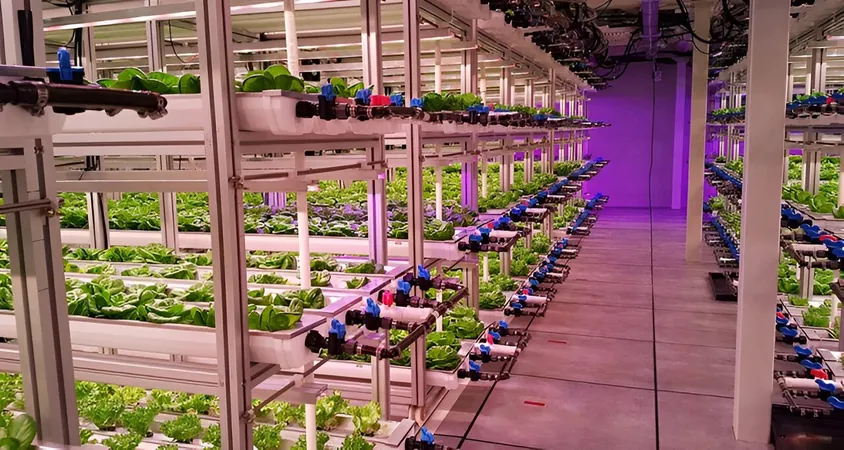
Revolutionizing Vertical Farming: Dynamic Environmental Control Cuts Costs and Boosts Crop Health!
2024-10-09
Author: Emily
Introduction
Vertical farming is becoming a game-changer in the agricultural landscape, offering a method of cultivating plants in vertically stacked layers, often within urban settings such as near supermarkets. This innovative approach allows for fresh vegetable production in areas that typically lack the necessary growing conditions, including harsh deserts and chilly, dimly lit regions.
Challenges of Vertical Farming
Despite its potential, large-scale implementation of vertical farming faces several hurdles, particularly concerning high energy consumption. Fortunately, groundbreaking research from Wageningen University & Research has unveiled that optimizing artificial light usage can significantly reduce energy costs while enhancing plant health.
Dynamic Lighting for Optimal Growth
In vertical farms, every aspect of the growing environment can be meticulously controlled. This level of detail is essential for achieving high yields, premium quality, and efficient resource utilization, including water and nutrients. However, this precision often leads to excessive energy use, with many farms providing the same illumination and temperature settings around the clock—even when it isn’t necessary.
According to Leo Marcelis, a researcher at Wageningen University & Research, “Adopting a more dynamic approach can significantly reduce energy costs while maintaining or even improving plant development.” This means adjusting light intensity to better suit plants' needs throughout the day, rather than adhering to a static schedule.
Energy Cost Reduction
The key insight from the study emphasizes the role of lighting in plant photosynthesis and growth. Different wavelengths of light that plants utilize affect their development uniquely. By understanding that plants do not require the same light settings at all times, a flexible environmental control system can be implemented. This approach can not only improve plant growth and quality but also allows farmers to take advantage of lower energy tariffs during off-peak hours.
Research reveals that by merely adjusting light intensity throughout the day, vertical farms could slash energy costs by up to 12%. The team investigated how variable light conditions influenced the growth of leafy vegetables, like spinach, commonly cultivated in vertical systems. The findings were promising; there were no adverse effects observed with the introduction of irregular lighting fluctuations.
A Promising Future for Horticulture
Not only can traditional greenhouses adapt similar dynamic lighting and temperature controls, but the advent of sustainable energy sources, such as solar and wind, allows for an even greater response to the ever-changing energy landscape. Fluctuations in energy availability present both challenges and opportunities for efficient energy use within both vertical farms and greenhouses.
Developing specialized plant cultivars tailored for vertical farming environments can further boost profitability. This tailored approach enables growers to prioritize flavor and nutritional value—attributes that far surpass the focus on firmness and shelf life which have often taken precedence in traditional agricultural practices.
Conclusion
Despite the promise of vertical farming, the pathway to widespread adoption remains fraught with challenges. Many of the innovative solutions proposed have yet to undergo comprehensive testing. Moreover, farmers require advanced sensors and models to effectively implement dynamic environmental controls.
“If we can manage environmental factors dynamically in vertical farms, we can drastically lower energy consumption and costs, leading to enhanced profitability and sustainability,” concludes Marcelis.
As the world grapples with food security and the challenges imposed by climate change, dynamic environmental control could unlock the full potential of vertical farming, paving the way for a more sustainable agricultural future.









 Brasil (PT)
Brasil (PT)
 Canada (EN)
Canada (EN)
 Chile (ES)
Chile (ES)
 España (ES)
España (ES)
 France (FR)
France (FR)
 Hong Kong (EN)
Hong Kong (EN)
 Italia (IT)
Italia (IT)
 日本 (JA)
日本 (JA)
 Magyarország (HU)
Magyarország (HU)
 Norge (NO)
Norge (NO)
 Polska (PL)
Polska (PL)
 Schweiz (DE)
Schweiz (DE)
 Singapore (EN)
Singapore (EN)
 Sverige (SV)
Sverige (SV)
 Suomi (FI)
Suomi (FI)
 Türkiye (TR)
Türkiye (TR)